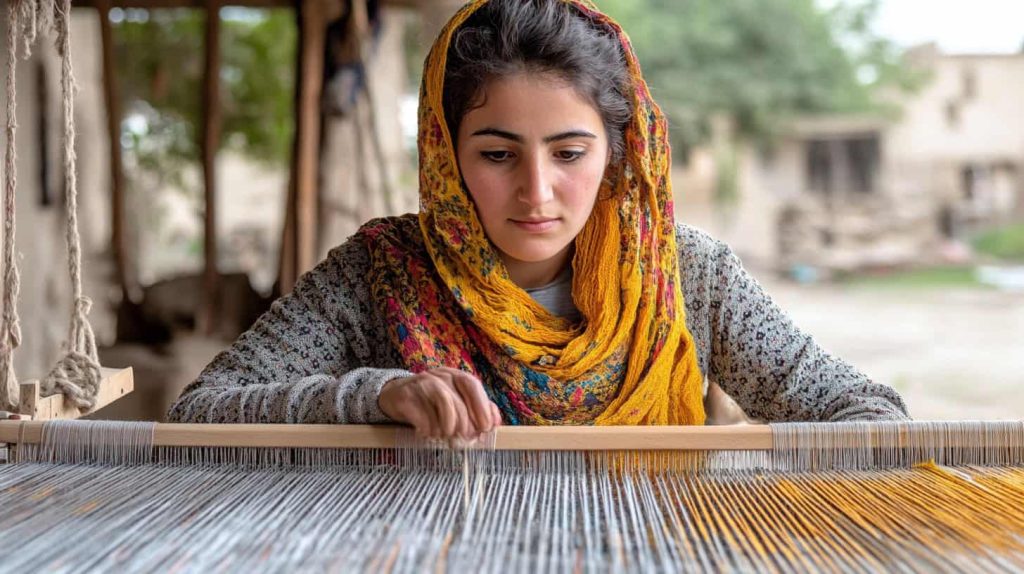When you walk through a handloom cluster in India — say, the narrow streets of Chendamangalam in Kerala or the looms of Varanasi’s Madanpura — you can hear a rhythm. Not the rhythm of machines, but of stories: families that have woven the same patterns for generations, women who know by touch whether the warp is perfect, and men who count threads not by math, but by instinct.
Now imagine that rhythm replaced by a timer. Deadlines. Branding manuals. Export targets.
Welcome to the modern race to “scale handlooms globally.”
It’s a noble dream — but one with a dangerous edge.
Because when you push modernization without mindfulness, you risk turning handloom into just another product — polished, profitable, and painfully soulless.
⚖️ The Modernization Dilemma: Between Preservation and Progress
India’s handloom sector employs over 43 lakh artisans across 2.5 million looms, according to the Ministry of Textiles. It’s the second-largest rural employment source after agriculture. Yet, the same sector stands at a fragile crossroads — crushed between nostalgia and necessity.
Government programs like the National Handloom Development Programme (NHDP), e-commerce tie-ups, and GI tagging initiatives all promise to uplift artisans by connecting them to global markets. Platforms like Amazon Karigar, Flipkart Samarth, and private ventures like Handlooom.com (the world’s first blockchain-integrated D2C handloom marketplace) aim to digitize and brand the sector for new-age buyers.
But here’s the paradox:
The very process meant to empower artisans can also erase their identity.
🧶 What Happens When “Scaling” Overpowers “Storytelling”
1. Design Homogenization
When the global market demands “consistency,” handlooms lose their unpredictability — their charm.
Every saree that used to tell a slightly different story starts to look the same.
The Balaramapuram Kasavu, once handwoven with temple-inspired borders, now gets digitally printed gold strips for speed.
The Pochampally Ikat, known for its complex dyeing craft, is mass-replicated on powerlooms for export.
Result? Faster sales. Lesser soul.
2. Artisan Marginalization
As modernization accelerates, not every artisan can keep up.
A weaver in Kuthampully who doesn’t own a smartphone or can’t fill an e-commerce listing form gets quietly left behind.
Middlemen re-emerge — not in lungis this time, but in suits. The hierarchy modernizes, but the exploitation persists.
A 2023 NIFT study found that over 68% of weavers in cooperative societies reported losing orders to semi-mechanized looms that falsely label their output as “handloom.”
This “fake handloom” industry is the elephant in the room — worth an estimated ₹10,000+ crore annually.
3. Cultural Dilution
Global branding often demands simplification. The intricate Sungudi of Tamil Nadu becomes “tie-dye cotton.” The handspun Muga Silk of Assam is sold as “eco-silk.”
The West may appreciate the beauty, but rarely the context.
And every time we simplify, a chapter of India’s textile history is quietly erased.
🌍 Real-World Parallels: Lessons from Other Nations
This isn’t uniquely Indian.
- Japan’s Kimono industry faced similar strain when it tried to “scale globally.” Fast-fashion knockoffs made from polyester nearly killed traditional silk kimono artisans.
- Peru’s Alpaca wool weavers went through a phase where fashion houses wanted only standardized “neutral tones” for Western markets, killing indigenous dyeing traditions.
- Africa’s Kente cloth faced mass-production in China — cheaper, faster, but fake.
The outcome everywhere was the same: commercialization without compensation, visibility without voice.
🪡 Is There a Middle Path? Yes — If We Redefine “Scaling”
Scaling doesn’t have to mean mechanizing.
It can mean modernizing the model, not the loom.
Here’s how:
1. Digital Product Passports (DPP) for Transparency
Save Handloom Foundation is already piloting NFC and QR-enabled Digital Product Passports that link every handloom product to its weaver, raw material, and dyeing process.
This means a buyer in Paris can scan a Chendamangalam Mundu and see:
“Woven by Lakshmi Amma, 58, using organic cotton sourced from Dindigul, dyed with natural indigo.”
That’s scaling authenticity, not replacing it.
2. 50:50 Weaver Procurement Model
A revolutionary model where weavers receive 50% advance for yarn and dyes and the remaining 50% post-delivery ensures they aren’t crushed under credit or middlemen.
This is the model Save Handloom Foundation and Handlooom.com are scaling across 2025–26 for over 5,000+ weavers.
3. Cluster-Led Branding, Not Corporate Branding
Let Kuthampully, Pochampally, Bhujodi, and Chendamangalam each be the brand.
Not a single homogenized “India Handloom.”
Imagine “The Bhujodi Story” — where every product carries the artisan community’s name, logo, and profit share.
4. Education + Tech for Artisans
Instead of replacing artisans, empower them.
Train them to manage listings, use traceability apps, and understand global design cues.
When artisans understand the market, they become entrepreneurs, not laborers.
💡 Examples of Balancing Both Worlds
| Initiative | Outcome |
|---|---|
| Fabindia’s Village Industries Program | Helped weavers retain local production but access national markets — though criticized for low artisan margins. |
| Handlooom.com (Blockchain Integration) | A first-of-its-kind D2C handloom platform where every saree or dhoti carries traceable weaver data and a 1-year “Handloom Integrity Assurance.” |
| Khadi India’s Digital Rebranding | Shifted from “freedom fabric” nostalgia to eco-luxury narrative, boosting urban youth interest. |
| Save Handloom Foundation’s DPP Pilot with Kerala Directorate | QR/NFC-based traceability rollout proposed for Hantex and cooperative clusters, making artisan details visible and verifiable. |
🧭 The Future of Indian Handloom: Two Roads Diverge
We stand at a defining moment.
Either India becomes the world’s biggest exporter of authentic, transparent handloom — or the world’s largest imitator of its own heritage.
If we scale without authenticity, we’ll create more “brands” but fewer craftsmen.
If we scale with authenticity — traceable, transparent, artisan-led — we won’t just preserve handloom; we’ll future-proof it.
🕯️ Final Thought
Modernization is inevitable. But soulless modernization is optional.
India’s handloom heritage isn’t a burden to update — it’s a compass to follow.
Let’s not “save” handloom by sanitizing it for the global market.
Let’s elevate it — with tech, transparency, and truth.
Because when a loom goes silent, it’s not just a thread that breaks —
It’s a story that disappears.

